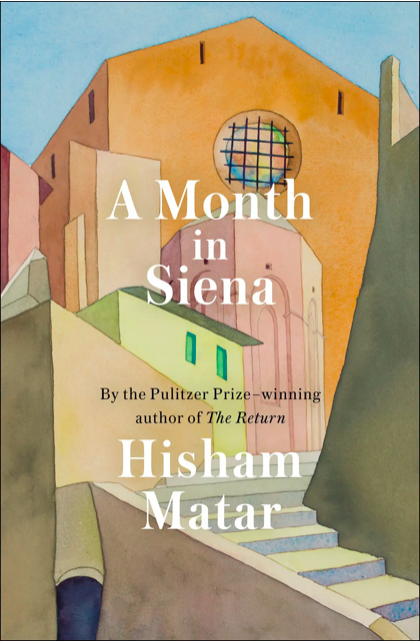A Month in Siena Review: A Visit’s Scenic Grief

By: María Teresa Fidalgo-Azize | Arab America Contributing Writer
I knew that I had come to Siena not only to look at paintings. I had also come to
grieve alone, to consider a new terrain and to work out how I might continue from here.
Hisham Matar, A Month in Siena
Hisham Matar’s Pulitzer winning 2017 memoir The Return personifies the hopelessness of healing when grieving a father’s death whose burial grounds he will never know. Jaballah Matar- Hisham’s father- was a political dissident of the Libyan dictator Muammar Gaddafi’s regime. He was abducted in Cairo in March of 1990- what was to become of him is lost, loosely memorialized in anecdotal evidence of his cellmates in the Abu Salim prison. Amidst the Arab Spring, Hisham returns to Libya after twenty-five years in exile in pursuit of attaining something physical- graspable- of his father who is left to be a ghost.
After finishing what is felt as a blood-soaked signature of bereavement, The Return, and the period of its publication, Matar decides to take a solitary visit for one month to Siena, Italy. It is here that the non-fiction work of A Month in Siena emerges- a sojourn keen in the flattened and confrontational art of Sienese painting- one which provided a bittersweet impression of well-being in the over than twenty-five years wait of seeking for clarity in his father’s disappearance.
Along with select images of Sienese paintings, blueprints of his one month stay, Matar’s sharp sensitive prose in A Month in Siena and his description of space and art intrigue the reader. What is written outrivals academic art-history analysis or mourning soliloquies for a journey searching for belonging.
The Nostalgia of a Stranger’s Company
To cross it is to take part in a centuries-old choreography, one meant to remind all solitary beings that it was neither good nor possible to exist entirely alone.
Hisham Matar, A Month in Siena
For most of the memoir, Matar finds himself alone- either after his daily Italian classes, unlimited museum trips, or occasional cemetery visits. Absorbed in Christian theology iconography and depictions of holy/profane events, contemplating paintings such as Caravaggio’s “Death with the Head of Goliath[1]” and Lorenzetti’s “Allegory of Good and Bad Government”, the instances of human connection beyond artistic representations are scarce, yet when presented, reinvent what it means to be alone in the company of others. Upon hearing the familiarity of the Arabic language, Matar introduces himself to a kindhearted stranger, Adam, and his children. They are Jordanian and live in Siena as what is known as economic migrants. Parallel reality from Matar’s leisurely travels. However, a comraderie begins as Adam extends an invitation for coffee and friendship. Startled by the warmth bestowed to an absolute stranger, Matar— contrary to his intentions of solitary sojourn — embraces what is felt like a lifelong relationship with Adam and his family.
Throughout the memoir, Matar’s relationship to Siena as a city and a quasi-person-place can be observed from a dueling private and public dynamic. His connection to the city undoubtedly corresponds to his unresolvable affair with grief- yet it is done in the open spaces of museums and murals. The company of strangers and later in his visit with an old friend who lives nearby imbues this reading with a metaphoric realization that solitude is interconnected not with loneliness but with the possibility of being open. The fear of both being recognized and left behind.
Conclusion
I exist mostly to one side of time. Only in rare moments- for example when I am with those I love or in times of great exuberance or when I am writing and the work is going well do I feel in time, that I am where I am meant to be and utterly free from the wish to be anywhere else.
Hisham Matar, A Month in Siena
Responsiveness between the past and its memory in the present occupy, crystalize throughout Matar’s discussion and explanations of Sienese art. Time exists in a loop-unfinished, not sealed with deadline specificity. In the chapter “The Fire”, he expresses how Siena gifted him the occasion to belong to a time and place that was not fully known despite its moderate size. It is in this state of wonder that he feels rooted in time. At the end of the memoir, Matar has already concluded his trip and returned to New York where he visits the Metropolitan Museum of Art engaging with the painting Paradiso by Giovanni di Paolo. It is in his description where the noeme of A Month in Siena follows: endlessly reshaping the meeting with a loved one, locking eyes into a forever.
Works Cited
Matar, Hisham. A Month in Siena. Random House. 2019
Silber, Joan. “Hisham Matar Spent ‘A Month in Siena’ Staring at Art.” The New York Times, The New York Times, 22 Oct. 2019, www.nytimes.com/2019/10/22/books/review/a-month-in-siena-hisham-matar.html.
Smith, PD. “A Month in Siena by Hisham Matar Review – Art, Love and Loss.” The Guardian, Guardian News and Media, 9 Nov. 2019, www.theguardian.com/books/2019/nov/09/a-month-in-siena-by-hisham-matar-review.
[1] Matar’s analysis captivates because it hovers around the question of what is gained after the desire of vengeance is satiated when one’s enemy is killed. He states that when one of the opposing factors is eliminated, confusion elapses troubling the survivor’s identity- disturbing the language of self.
Check out Arab America’s blog here !









